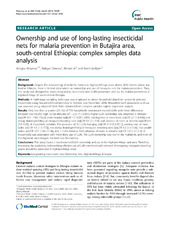| dc.contributor.author | Woyessa, Adugna | en_US |
| dc.contributor.author | Deressa, Wakgari | en_US |
| dc.contributor.author | Ali, Ahmed | en_US |
| dc.contributor.author | Lindtjørn, Bernt | en_US |
| dc.date.accessioned | 2015-02-02T09:54:19Z | |
| dc.date.available | 2015-02-02T09:54:19Z | |
| dc.date.issued | 2014-01-31 | eng |
| dc.identifier.issn | 1471-2458 | |
| dc.identifier.uri | https://hdl.handle.net/1956/9313 | |
| dc.description.abstract | Background: Despite the encroaching of endemic malaria to highland-fringe areas above 2000 meters above sea level in Ethiopia, there is limited information on ownership and use of mosquito nets for malaria prevention. Thus, this study was designed to assess long-lasting insecticidal nets (LLIN) possession and use for malaria prevention in highland-fringe of south-central Ethiopia. Methods: A multi-stage sampling technique was employed to obtain household data from randomly selected households using household head interview in October and November 2008. Household LLIN possession and use was assessed using adjusted Odds Ratio obtained from complex samples logistic regression analysis. Results: Only less than a quarter (23.1%) of 739 households interviewed owned LLINs with more differences between low (54.2%) high (3.5%) altitudes (Χ2 =253, P < 0.001). Higher LLIN ownership was observed in illiterate (adj.OR 35.1 [10.6-116.2]), male-headed (adj.OR 1.7 [1.051-2.89]), owning two or more beds (adj.OR 2.7 [1.6-4.6]), not doing draining/refilling of mosquito breeding sites (adj.OR 3.4 [2.1-5.5]) and absence of rivers or streams (adj.OR 6.4 [3.5-11.8]) of household variables. The presence of ≥2 LLINs hanging (adj.OR 21.0 [5.2-85.1]), owning two or more LLINs (adj.OR 4.8 [1.3-17.5]), not doing draining/refilling of mosquito breeding sites (adj.OR 4.2 [1.3-13.6]), low wealth status (adj.OR 3.55 [1.04-12.14]), and < 1 km distance from absence of rivers or streams (adj.OR 3.9 [1.2-12.1]) of households was associated with more likely use of LLIN. The LLIN ownership was low in the highlands, and most of the highland users bought the bed nets themselves. Conclusions: This study found a low household LLIN ownership and use in the highland-fringe rural area. Therefore, improving the availability and teaching effective use of LLIN combined with removal of temporary mosquito breeding places should be prioritized in highland-fringe areas. | en_US |
| dc.language.iso | eng | eng |
| dc.publisher | BioMed Central | eng |
| dc.rights | Attribution CC BY | eng |
| dc.rights.uri | http://creativecommons.org/licenses/by/2.0 | eng |
| dc.subject | Long-lasting insecticidal nets | eng |
| dc.subject | Highland-fringe | eng |
| dc.subject | Ethiopia | eng |
| dc.title | Ownership and use of long-lasting insecticidal nets for malaria prevention in Butajira area, south-central Ethiopia: complex samples data analysis | en_US |
| dc.type | Peer reviewed | |
| dc.type | Journal article | |
| dc.date.updated | 2014-02-05T20:03:26Z | |
| dc.description.version | publishedVersion | en_US |
| dc.rights.holder | Copyright 2014 Woyessa et al.; licensee BioMed Central Ltd. | |
| dc.rights.holder | Adugna Woyessa et al.; licensee BioMed Central Ltd. | |
| dc.source.articlenumber | 99 | |
| dc.identifier.doi | https://doi.org/10.1186/1471-2458-14-99 | |
| dc.identifier.cristin | 1161705 | |
| dc.source.journal | BMC Public Health | |
| dc.source.40 | 14 | |

